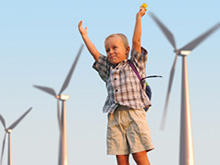Wind Turbines - Wind Power

Wind turbines generate electricity by utilising the power of the wind to turn the turbines. Micro systems are available for domestic properties and often referred to as 'small-wind turbines' or 'micro wind turbines'. Wind turbines produce electricity which can be used to provide power typical electrical appliances and replace energy which would have been probably previously purchased from the national grid.
The UK for example is an ideal country for small domestic wind turbines as approximately 40% of all the wind in Europe blows over the United Kingdom.
Types of wind turbines
The most popular turbine design is the horizontal axis wind turbine (HAWT) which is found in 2 main formats within the domestic market.
Mast mounted wind turbines
Wind turbine masts vary in height and construction though often found in 9m, 12m, 15m, though are free standing installations which are best to be placed in suitably exposed positions. Mast mounted wind turbines often have a power output of approximately 2.5kW to 6kW
Roof mounted wind turbines
Roof mounted turbines are generally smaller than mast mounted installations. They are mounted on the roof of the property (as per the description) where there is the required level of wind power. Roof mounted wind turbines are generally found with a power output of approximately 1kW to 2kW.
Mast mounted systems are generally considered to be more cost effective than roof-mounted installations, though they may not always be appropriate and dependent on the individual property. However, smaller roof mounted systems should not be discounted as they can produce reasonable amount of energy requirements in the right conditions and location.
How do wind turbines generate electricity?
Wind turbines work in a conceptually simple way; with the turbine being driven by the blades of the wind turbine as wind is blown against them. The large wind turbine blades (of which there are generally 3) are turned by the wind, powering a turbine which creates electricity which can be used or sold to the utility companies. You can read more about selling electricity to energy companies here.
The greater amount and force of the wind the faster and longer the blades will turn for which will increase the amount of electricity which is produced. However, wind technology is constantly improving which will allow electricity to be generated even in light winds.Domestic wind turbines work best in exposed places which have an average wind speed of about 5m/s which are not obstructed by for e.g. by trees or buildings with planning permission likely to be needed. Your local authority planning department will be able to confirm this though wind turbine installers are also likely to be able clarify you specific questions.
Why should I consider wind power?
- Wind power is a great renewable green energy which will help you to reduce your carbon footprint
- Electricity generated from wind power has minimal running costs after the initial purchase and installation of the wind turbine
- Wind turbines can be very tall though they only require a small area to be sited which allows the land below to be used with little disruption
Wind Turbine Savings
Recent research by the Energy Saving Trust found that a well sited 2.5kW domestic wind turbine could reduce electric bills by £380 a year and equated to an approximate reduction of 2.6 tonnes of carbon emissions per year.

 config
config view
view logs
logs 2048.0 KB
2048.0 KB



